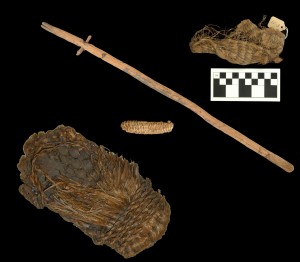
One reason why bluff shelters are such an important class of archeological site is the presence of rare, usually perishable artifacts. At open, or non-shelter, sites the only kinds of artifacts that usually survive are made of hard materials that don’t decompose quickly. Stone tools, ceramics, and sometimes bone will survive in the ground for thousands of years in many climates. What archeologists don’t usually find are the softer organic materials that past peoples used as tools or food. Things like baskets, clothing, food plants, cordage, and hafting elements of stone tools all rot except in rare circumstances. Either continuously wet environments like peat bogs or really dry environments like deserts can preserve soft organic perishable materials longer. This is why the dry overhangs of bluff shelters are such valuable archeological sites. In a region that is often wet and typically has very poor preservation of perishable items, these shelters are particularly interesting to researchers. They are rare dry pockets that preserve perishable artifacts in an otherwise wet climate that promotes rot.
But why do archeologists care about perishable items? Some researchers estimate that on most archeological sites only about 5% of the material record of human behavior survives. Perishable materials from bluff shelter contexts help us fill in the picture of the rest of the Native American tool kit at different points in the past, and teach us about foodways and the domestication of plants in the New World.